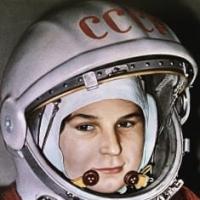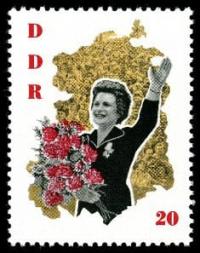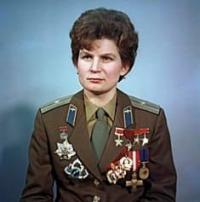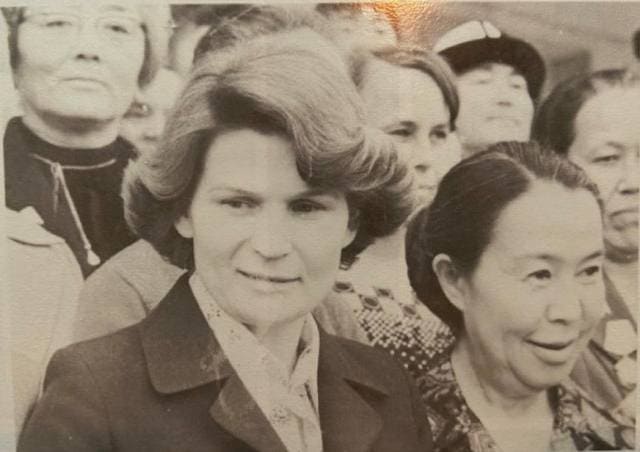You are here
World's first woman astronaut.



First flights into space.
"Hey! Sky! Take off your hat!
Valentina Tereshkova.
First female cosmonaut is Valentina Tereshkova.
Valentina Tereshkova was born in the village of Bolshoye Maslennikovo near the town of Tutaev, Yaroslavl region, on March 6, 1937 into a peasant family of immigrants from Belarus. Father - Tereshkov Vladimir Aksenovich (1912 - 1940), originally from the village of Vyylovo, Belynichi district, Mogilev region, tractor driver. He was drafted into the Red Army in 1939 and died in the Soviet-Finnish War).
Mother - Tereshkova (nee Kruglova) Elena Fedorovna (1913 - 1987), from the village of Eremeevshchina, Dubrovensky district, Vitebsk region, textile factory worker. The family also included an older sister, Lyudmila, and a younger brother, Vladimir.
In 1945 she entered secondary school No. 32 in the city of Yaroslavl (the school now bears her name). Having an ear for music, in her free time she learned to play the domra. She graduated from seven classes in 1953.
To help the family, in 1954 Valentina went to work at the Yaroslavl Tire Plant as a bracelet maker in the assembly and vulcanization shop in the preparatory operation, where she operated a diagonal cutting machine.
At the same time, in 1954 - 1955, she studied in the 8th - 9th evening classes of working youth school No. 10 in the city of Yaroslavl. Since April 1955, she worked as a roving worker in the tape shop of the Yaroslavl technical textiles plant "Krasny Perekop" (her mother and older sister also worked at the plant).
From 1955 to 1960, she studied at the Yaroslavl Correspondence College of Light Industry as a cotton spinning technologist. In 1957 she joined the Komsomol. From August 11, 1960 to March 1962 - released secretary of the Komsomol committee of the Krasny Perekop plant. She played the domra in the folk instruments orchestra of the plant's cultural center.
Since 1959, she has been involved in parachuting at the Yaroslavl flying club (performed 90 jumps). After the first successful flights of Soviet cosmonauts, Sergei Korolev had the idea to launch a female cosmonaut into space.
At the beginning of 1962, a search began for applicants according to the following criteria: parachutist, under 30 years of age, up to 170 cm tall and weighing up to 70 kilograms. Out of hundreds of candidates, five were chosen: Zhanna Yorkina, Tatyana Kuznetsova, Valentina Ponomareva, Irina Solovyova and Valentina Tereshkova.
Immediately after being accepted into the cosmonaut corps, Tereshkova, along with the other girls, was called up for compulsory military service with the rank of privates. Tereshkova was enrolled in the cosmonaut corps on March 12, 1962 and began training as a student-cosmonaut of the 2nd detachment.
On November 29, 1962, she passed her final exams in OKP with “excellent” marks. Since December 1, 1962, Tereshkova has been a cosmonaut of the 1st detachment of the 1st department. On June 16, 1963, that is, immediately after the flight, she became an instructor-cosmonaut of the 1st detachment and held this position until March 14, 1966.
During the training, she underwent training on the body’s resistance to the factors of space flight. The training included a thermal chamber, where she had to be in a flight suit at a temperature of +70 ° C and a humidity of 30%, and a soundproof chamber - a room isolated from sounds, where each candidate had to spend 10 days.
Zero-gravity training took place on the MiG-15. When performing a parabolic slide, weightlessness was established inside the plane for 40 seconds, and there were 3-4 such sessions per flight. During each session, it was necessary to complete the next task: write your first and last name, try to eat, talk on the radio.
Particular attention was paid to parachute training, since the astronaut ejected before landing and landed separately by parachute. Since there was always a risk of splashdown of the descent vehicle, training was also carried out on parachute jumps in the sea, in a technological, that is, not tailored to size, spacesuit.
Initially, it was planned for two female crews to fly simultaneously, but in March 1963 this plan was abandoned, and the task became to choose one of five candidates. When choosing Tereshkova for the role of the first female cosmonaut, in addition to successfully completing training, also took into account political aspects: Tereshkova was from the workers, while, for example, Ponomareva and Solovyova were from the employees.
In addition, Tereshkova's father, Vladimir, died during the Soviet-Finnish War when she was two years old. After the flight, when Tereshkova was asked how the Soviet Union could thank her for her service, she asked to find the place where her father died.
Not the least selection criterion was the candidate’s ability to conduct active social activities - meeting people, speaking in public on numerous trips around the country and the world, demonstrating in every possible way the advantages of the Soviet system.
Other candidates, with no worse preparation (based on the results of a medical examination and theoretical preparedness of female cosmonaut candidates, Tereshkova was placed in last place), were noticeably inferior to Tereshkova in the qualities necessary for such social activities.
Therefore, she was appointed as the main candidate for the flight, I.B. Solovyov as a backup, and V.L. Ponomarev as a reserve. At the time of Tereshkova’s appointment as Vostok-6 pilot, she was 10 years younger than Gordon Cooper, the youngest of the first group of American astronauts.
26-year-old Tereshkova made her space flight on Sunday, June 16, 1963 on the Vostok-6 spacecraft at 09:29 in the morning, it lasted almost three days, landing on Wednesday, June 19 in the Altai Territory at 06:28.
n total, Tereshkova made 49 orbits around the orbit. On June 17, Tereshkova photographed the Earth's horizon. At the same time, the Vostok-5 spacecraft, piloted by cosmonaut Valery Bykovsky, was in orbit. On the day of her flight into space, Tereshkova told her family that she was leaving for a parachute competition; they learned about the flight from the news on the radio. Lieutenant General Nikolai Kamanin, who was involved in the selection and training of cosmonauts, described Tereshkova’s launch as follows:
“The preparation of the rocket, the ship and all maintenance operations went extremely smoothly. In terms of the clarity and coherence of the work of all services and systems, Tereshkova’s launch reminded me of Gagarin’s launch. As on April 12, 1961, on June 16, 1963, the flight was being prepared and started off well. Everyone who saw Tereshkova during the preparation of the launch and the launch of the spacecraft into orbit, who listened to her reports on the radio, unanimously stated:
“She had a better start than Popovich and Nikolaev.” Yes, I am very glad that I was not mistaken in choosing the first female astronaut.
Tereshkova’s call sign for the duration of the flight is “Seagull”. The phrase she said before the start: “Hey! Sky! Take off your hat!”, was a quote from V. Mayakovsky’s poem “A Cloud in Pants.”
During the flight, Nikolai Kamanin wrote:
“I talked to Tereshkova several times. It feels like she's tired, but she doesn't want to admit it. In the last communication session, she did not answer calls from the Leningrad IP. We turned on the television camera and saw that she was sleeping. I had to wake her up and talk to her about the upcoming landing and manual orientation. She tried to orient the ship twice and honestly admitted that she couldn’t get the pitch orientation right. This circumstance worries us all very much: if we have to land manually, and she cannot orient the ship, then it will not leave orbit. She answered our doubts: “Don’t worry, I’ll do everything in the morning.” She communicates well, thinks well, and hasn’t made a single mistake yet.”
Later it turned out that the commands issued by the pilot were inverted in the direction of control movement in manual mode (the ship turned in the wrong direction as when trained on the simulator). According to Tereshkova, the problem was the incorrect installation of the control wires: commands were given not to descend, but to raise the spacecraft’s orbit. In automatic mode, the polarity was correct, which made it possible to properly orient and land the ship.
Tereshkova remained silent about this incident for more than forty years, because S.P. Korolev asked her not to tell anyone about it. According to Doctor of Medical Sciences, Professor V.I. Yazdovsky, who was responsible for the medical support of the Soviet space program at that time, women tolerate the extreme stress of space flight worse on the 14th - 18th day of the menstrual cycle.
ince the launch of the launch vehicle that put Tereshkova into orbit was delayed for a day, and also, obviously, due to the strong psycho-emotional load when putting the ship into orbit, the flight mode prescribed by the doctors could not be maintained.
Yazdovsky also noted that “Tereshkova, according to telemetry and television monitoring, endured the flight mostly satisfactorily. Negotiations with ground communication stations were sluggish. She sharply limited her movements. She sat almost motionless. She clearly showed changes in her health of a vegetative nature.”
Tereshkova survived 48 revolutions around the Earth and spent almost three days in space, where she kept a logbook and took photographs of the horizon, which were later used to detect aerosol layers in the atmosphere.
The Vostok-6 descent module landed safely in the Baevsky district of the Altai Territory. Immediately after landing, despite medical instructions, Tereshkova ate local products after three days of discomfort. Tereshkova - pilot-cosmonaut of the USSR No. 6 (call sign - “Chaika”), 10th cosmonaut in the world; the only woman in the world to fly solo in space.
Before the flight, B. Egorova was the youngest (by date of birth) of those who flew into space. The next flight of a woman into space, Svetlana Savitskaya, took place 19 years later, in August 1982.

Authority and photos by
https://ru.wikipedia.org/wiki/%D0%A2%D0%B5%






